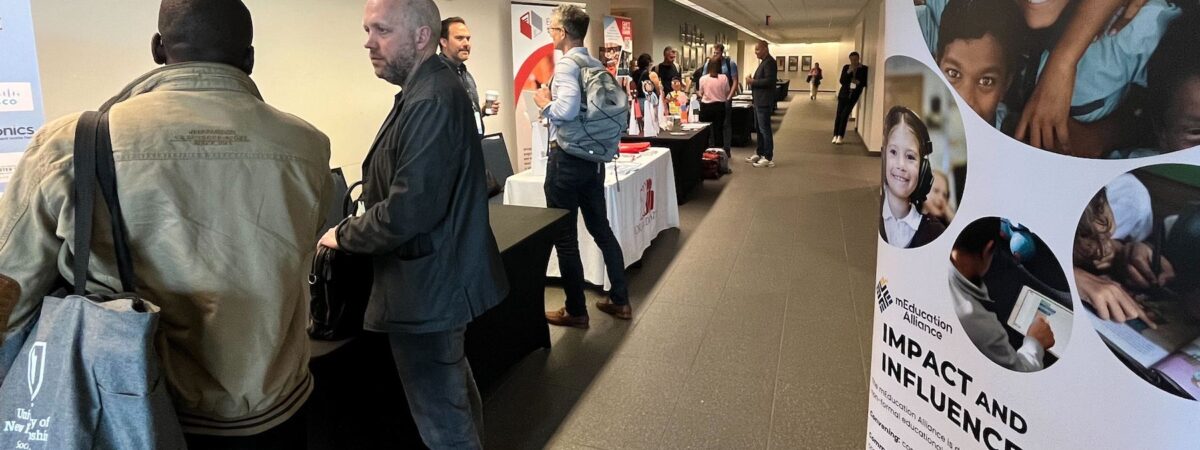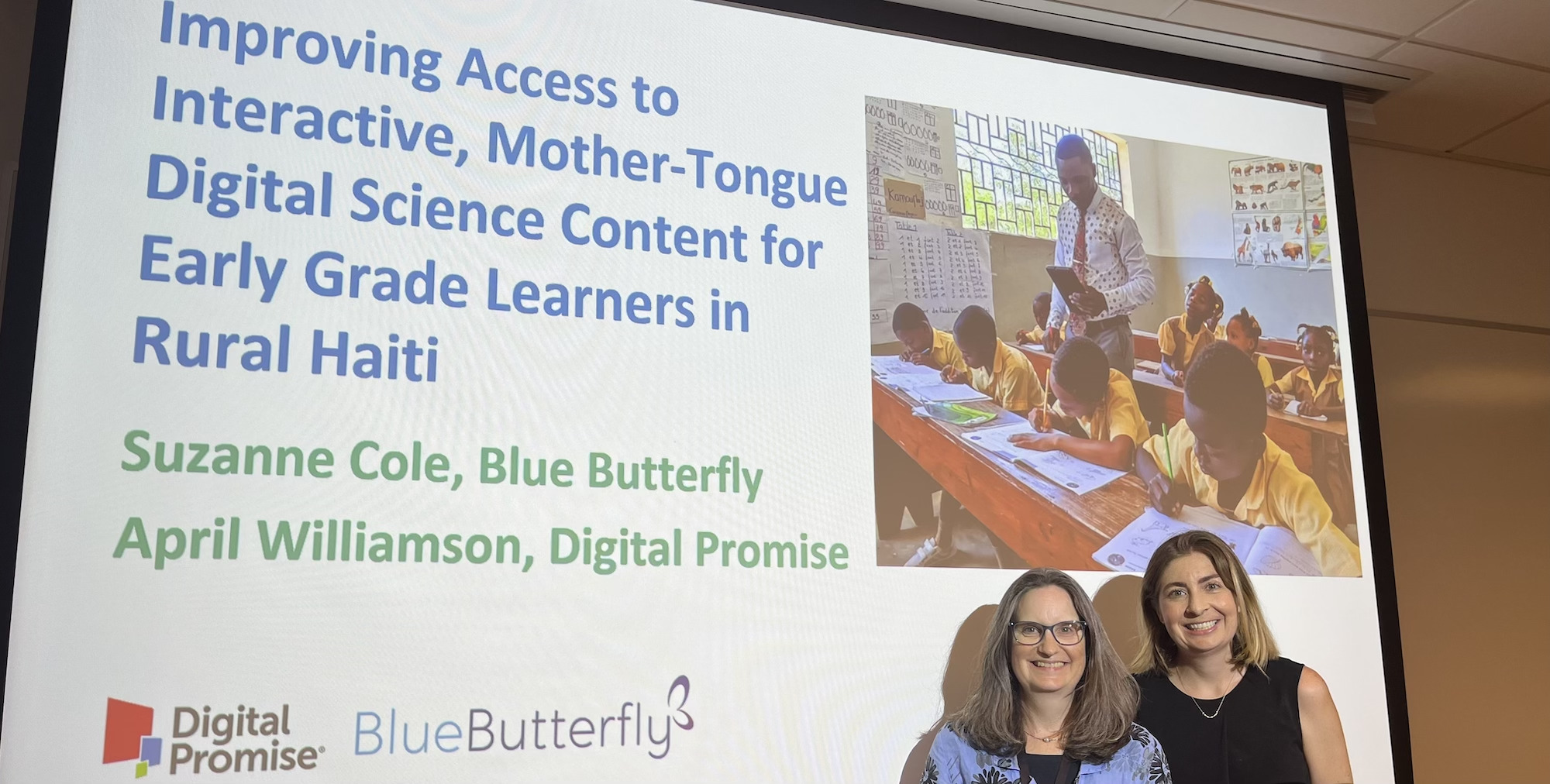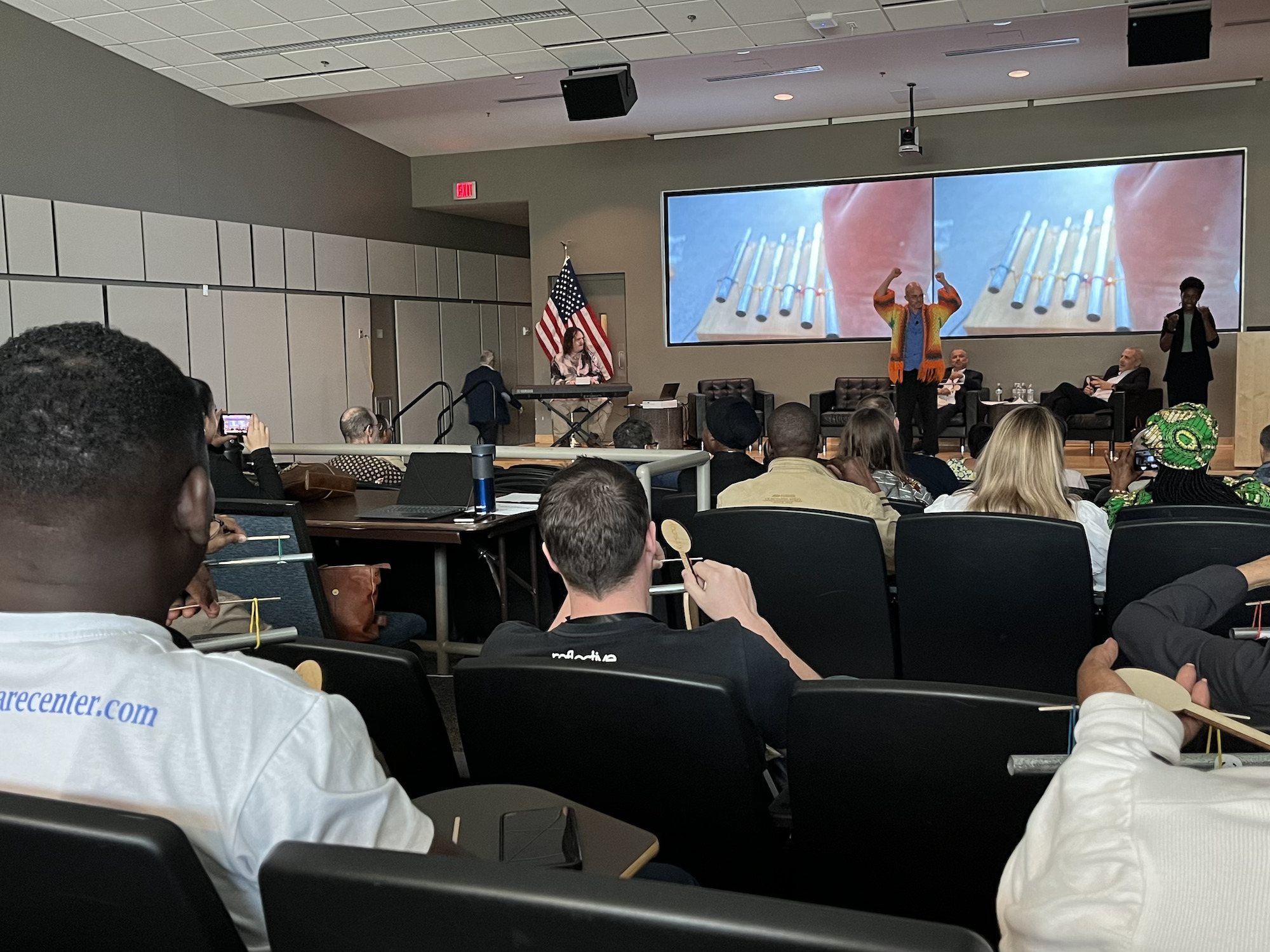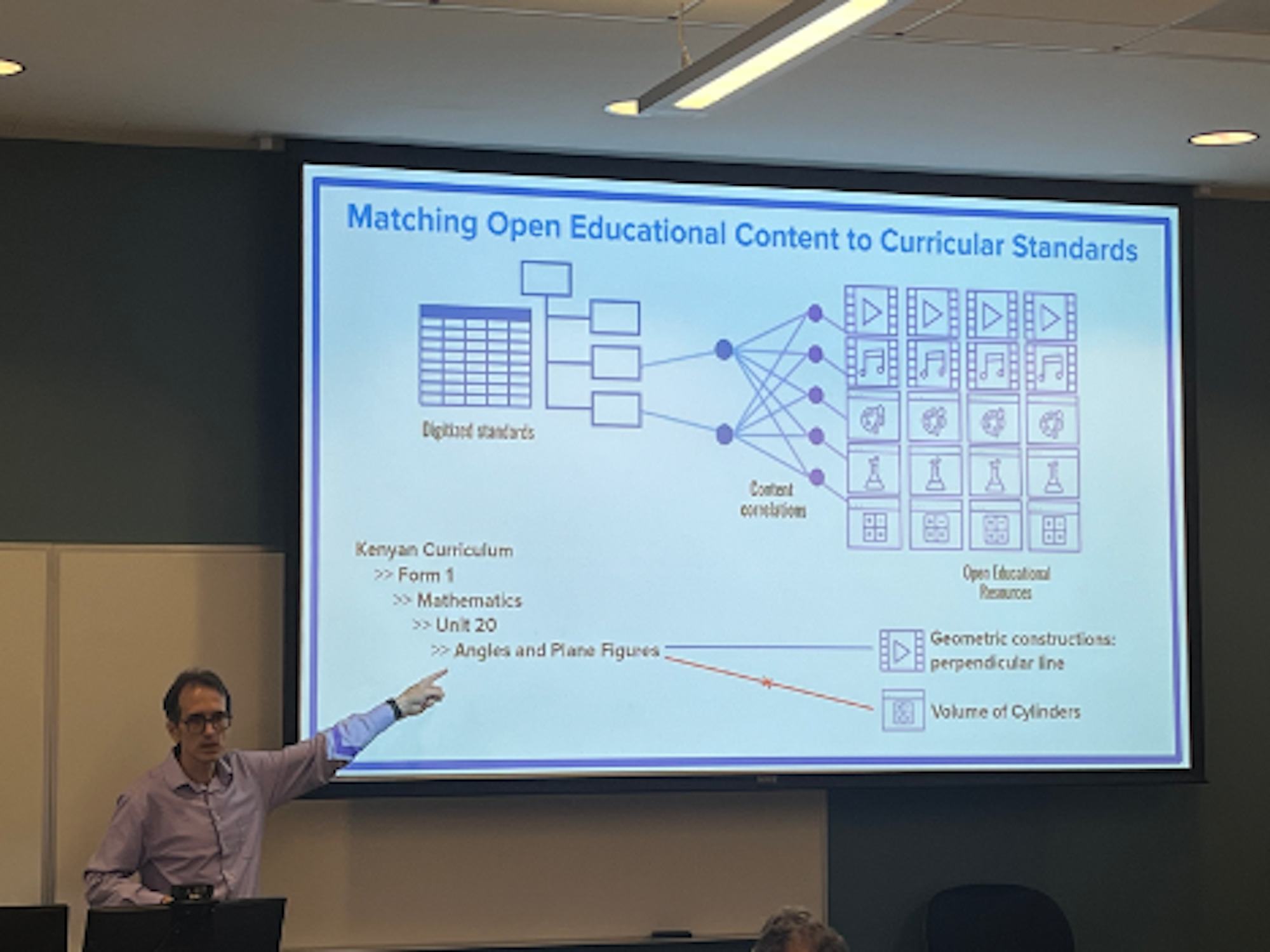
As part of that conversation, I presented alongside Suzanne Cole, director of operations at Blue Butterfly Collaborative, on the work of Digital Promise and Blue Butterfly to bring blended learning to primary schools in rural Haiti using interactive, mother-tongue digital science content.
Over the course of the symposium, I also attended a number of engaging presentations and discussions focused on STEM technology, engagement, and accessibility. Three key takeaways emerged for me from these sessions:

Suzanne Cole of Blue Butterfly and April Williamson of Digital Promise discuss their partnership to bring interactive, mother-tongue digital science content to Haitian primary schools.
Priyadarshani Joshi, senior research officer at UNESCO, presented lessons from the 2023 Global Education Monitoring (GEM) Report on education and technology, emphasizing that “technology offers an education lifeline for millions, but excludes many more.” For example, 72% of the world’s poorest children could not connect to distance learning during the pandemic. During a plenary session, David Barth, vice president of international programs at Save the Children, underlined the fact that, by default, all work at the intersection of technology and education has inequality embedded in it unless we actively address it.
The symposium highlighted a number of programs that are addressing this challenge. Nat Dinahm, partnerships lead at onebillion, shared their work in Malawi with the LEGO Foundation’s Play for All accelerator to design education technology for students with autism and ADHD through playful content co-creation sessions with neurodivergent children.
The All Children Reading: A Grand Challenge for Development EdTech Expo—a sister event to the symposium—commemorated the program’s work from 2011-2023. Sekerani Kufakwina, advocacy committee chairperson at the Malawi National Association of the Deaf, shared about efforts in Malawi to create open, accessible educational materials in Malawian Sign Language for deaf learners. Given that only 20% of deaf children globally have access to education, this work to design educational resources for marginalized communities first is critical.
One of Digital Promise’s partners, the N50 Project, is working in Zambia with Mwabu to use low-cost technologies, including smartphones and local servers, to deliver digital content and improve teaching in rural environments without power and connectivity. Helen Radford, head of product at Mwabu, spoke about early lessons from the pilot and noted, “We have learned that hardware can be simple, power requirements can be minimal, and costs can be reduced.”
Mobile phones in their most basic form also provide a promising vehicle for translating evidence-based pedagogies. Colin Crossley of Youth Impact’s ConnectED program shared results from a phone-based tutoring program to support basic math learning competencies that has been implemented in 11 countries. The evidence shows that simple mobile phones and 1:1 tutoring delivered via the phone can work across contexts, but that phone calls—involving human interaction—have been much more effective than SMS messages.
Other promising low-cost, low-tech edtech solutions featured in the symposium include interactive voice response (IVR) and pico projectors. Anthony Bloome, executive director of the mEducation Alliance, shared promising early data from the rollout of IVR-based math games and narratives for primary-aged learners in Rwanda. Rebecca Vieyra of the University of Colorado spoke about opportunities to use low-cost projectors in the classroom to share high-quality STEM content, such as PhET’s interactive lab simulations, which have been translated into 121 languages.
There are also opportunities to use low-cost, local materials to promote student exploration of the natural environment. In another session, Victor Minces, research scientist at the University of California, San Diego, led the audience through a series of sound experiments and music-making activities using everyday materials like coffee stirrers, rubber bands, and pipes. He emphasized that science, technology, and art have been linked throughout history and that children are natural scientists: they explore the physics of the world with their hands. However, things quickly change as they progress through the education system and unfortunately lose the opportunity to play, experiment, and be surprised by nature.

Victor Minces of the University of California, San Diego, leads symposium participants to create music using everyday materials.
Some programs featured at the symposium are bucking that trend. Heather Beem, CEO and founder of Practical Education Network, is bringing curriculum-aligned, hands-on STEM activities to Ghana and Liberia using low-cost, locally available lab materials, such as plastic bottles and balloons. The Haitian digital science learning program that Digital Promise and Blue Butterfly are implementing also involves using local natural materials to “hook” students.

Symposium participants watch a video on the use of local materials in the interactive science learning program that Digital Promise and Blue Butterfly are implementing in Haiti.
Jeff Goumas of World Education discussed the work of the CrowdED Learning program to facilitate “EdTech maker spaces”—service-learning professional development sessions for educators— in order to help them find resources on its OER platform; evaluate the quality and alignment of those resources; and design learning activities using the resources that promote learner engagement and accessibility. Nina Bolte also discussed the work of EIDU in Kenya to integrate high-quality digital content from multiple sources into a single coherent, low-cost learning platform that is being used in all 47 counties across the country.
While STEM technologies can be simple, there are also important opportunities to apply emerging technologies, such as machine learning, to the challenge of finding, organizing, and using digital resources.
One novel application of artificial intelligence (AI) highlighted at the symposium is supporting the time-consuming process of mapping large quantities of OERs to local standards. Jamie Alexandre, co-founder and executive director of Learning Equality (a Digital Promise partner on its Haiti Blended Learning pilot), discussed his work with UNHCR and Schmidt Futures to automate the process of curriculum alignment in low-resource contexts by using machine-learning algorithms. This work involves leveraging generative AI to put local learning standards into a consistent and usable format in order to organize a library of more than 200,000 open resources from multiple locations. A predictive machine learning model then matches the resources’ content to the right topic.

Jamie Alexandre of Learning Equality discusses his work to leverage machine learning to map open educational resources to local education standards.
Overall, I was struck by the energy and creativity being devoted to leveraging technology to tackle the challenge of delivering high-quality STEM learning opportunities to all children globally. The mEducation Alliance is a powerful vehicle for collaboration on this topic, but the conversation can’t stop with one three-day event. In the future, I’d love to see more participation from governments and philanthropies in order to increase funding coordination and ensure that small, local organizations doing innovative work in STEM education have the sustained resources they need to build on their progress.
Want to dive deeper?

We want to hear from you!
Please take this 5-minute survey and help us serve you better.
